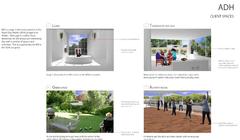Matthew Obbink ReportAmherst H. Wilder Center for Healthy Aging In 1906, the Wilder Foundation started its first Healthy Aging program when it sent nurses into the homes of the ill to provide care and support. Over the last hundred years, their Healthy Aging programs have evolved and expanded, but their function has remained the same: to promote health and well being of the clients while preserving their dignity and independence. With the baby boomer generation closing in on retirement, this function becomes more important than ever. My proposal for the new Wilder Center for Healthy Aging springs from Louis Sullivan’s well-worn quote, “form follows function.” Using efficiency and flexibility as driving design principles, the building fulfills all programmatic requirements while providing a wide variety of experiences for both clients and staff. For all who use the building daily, this approach offers the potential for change from day to day as required or desired. As mentioned earlier, the Wilder’s function is to promote health and well being of the clients while preserving their dignity and independence. Because this is the function of the building, I think the first and most important thing to think about is how the clients experience the building. My proposal for the project was presented in the form of a book that followed several different characters as they used the building. The purpose of this was to really think about the experience from the user’s perspective. This greatly helped me see the potential of completely different program elements being utilized in a single space. This allows the client the ability to use the same room or space more than once a day with a completely different experience. My vision for this building is an environment that allows the user to experience something new everyday. I believe that the repetition of arriving at the building, walking down the same hallway to the same room to do the same things everyday is not healthy nor does it give the client any sense of independence. One of the largest design drivers in my project was creating ways to give the clients the potential to have different experiences every day. The view I want the clients to have of my building is one of adventure. I want it not to be a place they must go everyday, but instead a home they want to come to. As the building changes to adapt to the daily needs of clients and staff, it will continue to spark their interest and imagination while deterring the boredom and monotony often associated with similar programs. My hope is that the inhabitants of the building will be proud to claim ownership, genuinely calling it home. Another significant design driver in my project was functionality. Regardless of how nice spaces are designed, if the program doesn’t function well it isn’t good design. The Wilder’s Healthy Aging program is very complex and has very specific needs. It was very important to me that my design not only contained great spaces for the users, but also fulfilled all the program requirements. My floor plan went through many iterations and continued to evolve throughout the semester until every aspect of the Wilder’s program was accounted for. I grouped staff functions in precise ways that allowed specific adjacencies of program to aid in the staff’s daily work. I want my architectural design to allow the staff to do the best job they can do as easily as possible. I believe the public realm of this project is crucial to its success. It is very important that the clients continue to feel connected to the community. The best way to create this connection is to bring the public directly into the building. Nursing homes come with the assumption of privacy and isolation. It is easy to feel more and more disconnected from the community as people grow older. This is something that absolutely needs to be addressed. Bringing the public to the clients makes a statement that they are still a significant part of the community. This goes a long way in preserving the clients’ dignity and independence. Providing public aspects of the building has many other advantages for the Wilder as well. The Healthy Aging program at the Wilder center is primarily a day time program. This leaves the building empty in the evenings. I saw this as a great design opportunity for the building. I designed the building in such a way that it can be rented out to hold various public functions in the evenings or even at different times throughout the day. The key is pocket doors that are placed in the walls throughout the building. These pocket doors provide countless ways of dividing up space and creating different levels of public access. Because security is a vital concern for the Wilder program, it is important that these doors are able to lock off certain areas of the building at certain times. Renting out space for public functions both helps generate revenue for this nonprofit organization as well as allows the Wilder to give back and stay connected to the community. This design for the new Wilder building focuses primarily on two large ideas: to promote health and well being of the clients while preserving their dignity and independence and to create function and flexible spaces that allow all the users to continue to receive new and meaningful experiences. My vision for this building is that it becomes a home for the clients as well as the community. Additional Help and InformationAre you in need of assistance? Please email info@berkeleyprize.org. |
|

